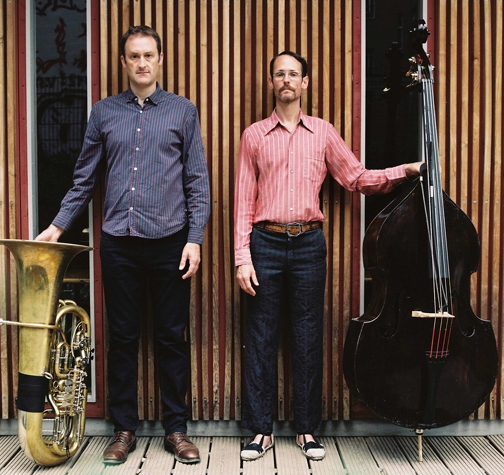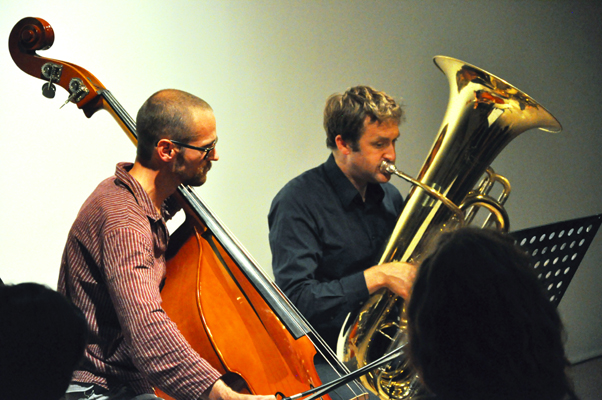ROBIN HAYWARD

Reidemeister Move's "Borromean Rings"
by Daniel Barbiero
(February 2019)
It's a Sunday evening at the end of September, and the final night of the 2018 Sonic Circuits DC Festival. Two men--one of them with a dark and weathered double bass, the other holding a tuba--sit side-by-side in silence. Then: a long downbow on an open string, accompanied by a long-blown note from the tuba. After this opening move--a gambit offered and a gambit accepted--a kind of sonic game of chess is on.
The two performers are tubist Robin Hayward and double bassist Christopher Williams, and the piece they have just begun is Hayward's composition "Borromean Rings."
Hayward and Williams, both of whom currently reside in Berlin, play music that delves into the possibilities--harmonic, timbral and psychoacoustic--of sustained tones in just intonation. They play together as Reidemeister Move, a name taken from knot theory. A Reidemeister move is one of three possible operations connecting two diagrams of equivalent knots. On a metaphorical level, the name is an apt one for what Hayward and Williams do, since much of their work represents the realization of possible musical gestures--many more than the knot theoretician's set of three, as it happens--linking two instruments roughly equivalent in compass and sustaining capacity. Essentially, this is music about connection both in concept and in concrete enactment.
Hayward, originally from Brighton, England, studied music at the University of Manchester and the Royal Northern College of Music, also in Manchester. He's responsible for developing the first fully microtonal tuba (in 2009); it's an instrument he's worked with extensively since then. Part of this work includes the creation in 2012 of the Hayward Tuning Vine, which he describes as a software interface for exploring the just intonation tuning system. His 2014 recording Star System, where he was joined by microtonal tubists Kristoffer Lo and Martin Taxt, featured long performances of two three-dimensional graphic scores derived from the Hayward Tuning Vine. Prior to his involvement with microtonal music, Hayward played improvised and experimental music in Manchester and London; he moved to Berlin in 1998.
Like Hayward, Williams has a background in experimental and improvised music. He studied music at the University of California in his native San Diego; among his teachers were double bassist Bertram Turetzky and composer Chaya Czernowin. His doctoral dissertation, "Tactile Paths: On and Through Notation for Improvisers," is a web-available examination of the possible ways that notation can both temper and express the contingency inherent in improvisation. In addition to his work with Hayward, Williams has composed for and collaborated on musical and multimedia projects with a diverse range of ensembles, individual musicians, dancers, visual artists and others. Notable among these is the 42-minute long Arcanum 17, a 2012 multimedia work for double bass, tuba, text and field recording based on Surrealist André Breton's myth-pervaded, wartime meditation of that name.
The performance continues in a series of overlapping tones, some of them separated by intervals small enough to cause beating patterns, and others in perfect consonance. Williams has established a pattern of using downbows exclusively, but unexpectedly he confounds it with two upbows. The difference in accent is subtle but under the circumstances introduces an element of drama; it's almost like seeing a smooth stream of water disrupted as it breaks over a small stone.
Composed in 2011, "Borromean Rings" is an open work that defines a set of possible harmonies whose realization is the product of individual choices made by the performers in real time. Like the duo's name, the composition's title is borrowed from knot theory and is a way to conceptualize connection: Borromean Rings are a set of three rings linked in such a way that the removal of one ring leaves the remaining two rings unlinked. A metaphor for the work? Yes, if we think of the emerging harmonies as playing the role of a link binding the otherwise independent voices of the tuba and double bass. A link that's chosen rather than given.
Hayward occasionally looks over to Williams in the interstices between soundings. What appears to be developing now is an intricate game of opposition and reconciliation. In fact, the title of Duchamp's odd chess book, The Opposition and Sister Squares Are Reconciled, suddenly comes to mind. The opposition has to do with the basic timbral profiles of the two instruments--the forward-leaning thrust of buzzed-lip brass versus the floating world of the bowed string. It isn't that Hayward is unduly aggressive, it's just a matter of a brass instrument behaving like a brass instrument. In addition to which, Williams plays with a noticeably light touch--there's little audible of the signature scratch of bowhair on string. Reconciliation is never far away: there have been many passages now where the timbres of both instruments fuse into a composite timbre--the voice of an imaginary hybrid instrument, a strange vox profundis of unknown provenance.

As with any good open work, "Borromean Rings" turns contingency to musical advantage, in this case by making possible the chance meeting of two voices on a well-prepared harmonic ground. Hayward's score consists of an elegantly simple circular staff sparely populated by single notes. Running along the outside perimeter a fraction appears underneath each note; these fractions describe the pitch of the note according to Just Intonation, that is, as a whole number ratio with reference to a constant fundamental tone (the composition's "keynote"). Running along the staff's inside perimeter are patterns of open and closed circles--fingering charts for the tuba. The score doesn't prescribe a set sequence of pitches or gestures that the performer must follow; rather, in Hayward's description, it serves as a framework "used to define a field of possible moves for navigating within harmonic space." Hayward compares it to a kind of non-competitive game of chess in which each player's move is meant to elicit a complementary, creative response from the other. To "win" is thus to construct a mobile network of sonorities resonating in the body and the mind.
And now something peculiar but arresting happens. Williams executes a series of bowstrokes on the open D string while Hayward plays a changing sequence of long pitches. The sound of Williams' open D string appears to change along with the changes in Hayward's part. Not just in timbre, which is to be expected, but the pitch itself seems to shift. It's an uncanny thing, almost as if the logical connection between what's seen and what's heard has become undone.
The harmonic space mapped out in "Borromean Rings"' score is a sonically rich space defined by microtonal relationships. Hayward sees the microtonality of "Borromean Rings" and other of his compositions as an extension of his earlier work, which was concerned with the production of predominantly unpitched noise. Hayward's interest then was in what he calls the "intrinsic quality of sound itself;" microtonality represents a way for him to get to the kinds of sonorous qualities he found attractive in noise, but from the other side, as it were. It is also a way for him to elicit a range of sounds from the tuba that he finds inherent in the instrument. For Hayward microtonality is natural to the tuba, for which the twelve tones of the equal-tempered octave are, by contrast, an artificially limiting condition--suitable for the piano, perhaps, but not to the tuba and its system of valve combinations. It's an instrument that wants to be microtonal; consequently, he's described his method of microtonal playing as involving "intrinsic"--again, that key term--rather than "extended" technique.
A similar observation can be made about the double bass. The unfretted fingerboard facilitates the easy production of microtones; using the ear and harmonic context as guides, a double bassist is likely to play some pitches sharper or flatter than they would be in equal temperament. This is as intrinsic to the double bass as is microtonality to the tuba. Adding to the double bass's natural sonority is the tuning Williams uses. His highest string is tuned up to an A rather than to the standard G; he feels the relationship of a fifth between the high A and the D string just below it, and the relationship of an octave between the high A and the low A string, give a resonance unobtainable in standard tuning. For a piece like "Borromean Rings," this extra degree of resonance serves to amplify the effects the composition is intended to create.
Hayward and Williams continue their moves and counter-moves. The sounds of the two instruments circle each other, converge and linger and then diverge. A brief pause, and they take up their moves again. The drama is subtle but discernible in the tensions of the harmonies; one harmony in particular holds the two voices just close enough to hold out the prospect of a resolution, but it fades before resolving. The vibrations seem to impact the solar plexus as well as the ear.
Although a fine performance recorded in a church in Brandenburg was issued in 2016, "Borromean Rings" is a piece that really needs to be experienced live to be experienced fully. At the most trivial level, it's impressive visually: the double bass and tuba are physically imposing instruments; the gestures needed to coax sound from them, not to mention the stamina this piece calls for, make distinctive demands on the performers which are easily seen. More centrally, the music itself carries a physical force of its own--this is music whose cumulative low tones are felt as much as heard, whether in the smooth mass of perfect consonance or in the fluttering beats of microtones jostling against each other.
It's difficult to tell how much time has passed since Hayward and Williams have begun playing. The recording of "Borromean Rings" is approximately thirty minutes long. It's possible that this performance is heading toward that length, but it doesn't feel it. The drawn-out harmonies elongate time to the point where its dimensions become meaningless; what takes its place is an enveloping resonance. Which gradually comes to an end. A pause, and Hayward and Williams stand up and bow deeply from the waist.